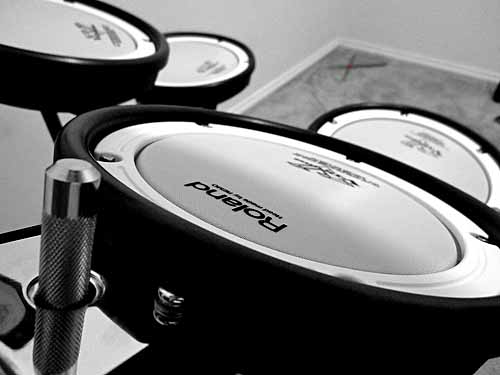If you’re shopping for electronic drums, the two brands you’re likely to see come up more than any others are Roland and Yamaha. Both are utilized in about equal amounts by professional percussionists, and each brand offers its own unique strengths that will make it the right choice for a certain kind of player. Both brands offer a wide array of different drum pad options at a variety of price points.
Whether you’re a professional percussionist or a student looking to practice without waking the neighbors, one of the 4 electronic kits below is bound to suit your needs. We’ll first go over some representative drums then we’ll have a section on which to choose so you figure out yourself which would be the winner in the Battle of Roland vs Yamaha Electronic Drums.
Roland vs Yamaha Electronic Drums Contender #1: the Roland TD-17KV-S
The TD-17KV-S is Roland’s newest V-drum kit, giving you a compact but powerful and versatile kit that’s equally at home on the stage as it is in the studio. The kit comes with a TD-17 sound module, a KD-10 kick pad, one PDX-12 snare pad, three PDX-8 tom pads, and three cymbal pads (CY-8’s for the crash or ride and a CY-5 hi-hat pad).
The mesh heads used on the drum pads have an incredibly natural feel and sound, and as an added bonus the kit is double-pedal friendly—perfect for metal and other fast bass drum work. It uses the SuperNATURAL and Behaviour Modelling sound engine that was first pioneered in their flagship TD-50 model, giving you the most authentic drum sound of any V-drum kit to date, with an impressively fast and accurate triggering response (see full specs).
If you’re looking for the top of the line in Roland V-drum technology, the TD-17KV-S kit is the right choice for you.
Roland vs Yamaha Electronic Drums Contender #2: Roland V-Drums TD-4KP
If you want to get a Roland V-drum kit but don’t have an unlimited budget, the TD-4KP kit is a more streamlined option that gives you the same high level of sound quality for a generally lower price and in a more compact package. It’s designed with ease of transportation in mind.
The frame has an easy-folding design and has a relatively small footprint even when fully set-up, making it the ideal option for smaller recording studios as well as for players who want to use it as a practice kit in a bedroom or apartment. It uses a TD-4 sound module and gives players eight different pads (kick drum, snare drum, three toms, hi-hat, and two cymbal pads to use for the crash and ride), meaning you’ll have the full range of sonic options along with the portable design.
Roland vs Yamaha Electronic Drums Contender #3: Yamaha DTX532K
Moving on to Yamaha’s V-drum catalogue, the DTX532K set is an excellent place to start. It’s designed to be easy to play for those who are used to traditional drum kits, something that’s especially noticeable in the cymbal pads. Unlike most drum kits, which use a pad attached to the rack for the hi-hat, it uses an actual hi-hat stand with a pedal trigger, and the hi-hat pad itself uses a dual-zone trigger, with different sounds for the edge and bell.
The other cymbals have three zones of sound (cup, bow, and edge) giving them a realistic feel and a full range of sounds, with a natural sway and the ability to choke the sound at any point along the edge. The drum pads (see full specs) are equally innovative, with a KP65 kick pad, an XP80 snare pad, and three TP70 tom pads.
What makes the DTX532K so powerful as a practice and training tool, however, are not the pads themselves but the on-board software, which features training functions to help you improve your rhythm, timing, and endurance. It can even track your progress over time, giving you a score so you know exactly how your session stacked up against the last one.
Roland vs Yamaha Electronic Drums Contender #4: Yamaha DTX 400K
On the affordable end of the Yamaha V-drum spectrum is the DTX 400K, which gives you a fully-functioning kit for not too much money. As with the Roland TD-4KP above, just because it’s affordable doesn’t mean you have to sacrifice quality. The included sound module gives you over 150 different acoustic percussion sounds to work with and includes an interactive training program that’s perfect for students hoping to hone their skills.
In terms of the pads, it utilizes the KU100 kick drum pad, designed to be truly silent, perfect for practicing in shared spaces. It also has four 7” pads for the toms and snare, a 10” hi-hat pad and two 10” cymbal pads to simulate the crash and ride. The 10 kit presets can be customized, as well, so you can save your drum sound settings and easily replicate them at your next gig.
Electronic Drums – Roland or Yamaha?
Both Roland and Yamaha produce high-quality v-drums that are widely utilized and respected in the professional percussion world. Generally speaking, the Roland models will cost a bit more than the equivalent level of Yamaha equipment; if your budget is a primary concern, you’ll get more bang for your buck going with a Yamaha kit, which is especially helpful if you’re mostly buying the kit for at home silent practice.
In terms of sound and feel, both brands are very comparable. Many musicians prefer the sound quality of the Yamaha v-drums, which use real samples as opposed to the synthesized sounds often utilized in Roland models. Conversely, the feel of the mesh Roland heads is more similar to that of traditional snare or tom heads, and many percussionists find Roland kits to be an easier transition from an acoustic kit. The compact size and portability of many Roland models is also an advantage, especially for recording engineers who don’t have a lot of space to work with in their studio.
Ultimately, the best way to choose whether Roland or Yamaha is right for you is to play around on the kits and find which one is best suited to your playing style and ideal sound. Both companies put out high-quality equipment that will stand up to significant playing without failure—meaning whichever way you decide to go, your new v-drums will last you for a good, long while.








